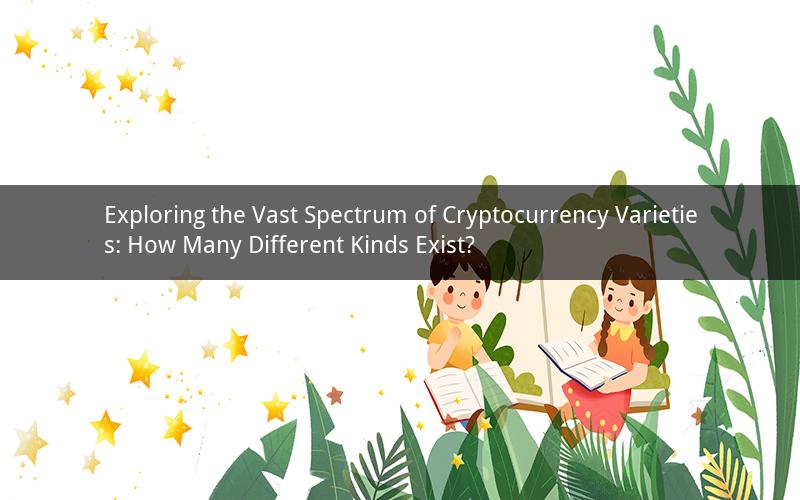
The cryptocurrency market has witnessed exponential growth in recent years, captivating the attention of investors, tech enthusiasts, and entrepreneurs alike. With numerous digital currencies vying for dominance, it is essential to understand the diversity and variety that exists within this rapidly evolving sector. In this article, we will delve into the vast spectrum of cryptocurrency varieties, shedding light on how many different kinds exist and their unique characteristics.
1. Bitcoin: The Pioneer of Cryptocurrency
Bitcoin, launched in 2009, is often referred to as the "grandfather" of cryptocurrencies. It introduced the world to the concept of decentralized digital currency, utilizing blockchain technology to enable secure transactions without the need for intermediaries. With a finite supply of 21 million coins, Bitcoin has become the most well-known and widely accepted cryptocurrency.
2. Ethereum: The Smart Contract Platform
Ethereum, launched in 2015, stands out as the second-largest cryptocurrency by market capitalization. It introduced the concept of smart contracts, allowing developers to build decentralized applications (DApps) and decentralized autonomous organizations (DAOs). Ethereum's native token, Ether (ETH), powers these applications and facilitates transactions on the network.
3. Litecoin: The Silver to Bitcoin's Gold
Litecoin, created in 2011 by Charlie Lee, is often referred to as the "silver" to Bitcoin's "gold." It was designed to be a faster and more scalable alternative to Bitcoin, with a shorter block generation time and a larger supply cap of 84 million coins. Litecoin has gained popularity among those looking for a more efficient and cost-effective cryptocurrency.
4. Ripple: The Financial Institution-Friendly Cryptocurrency
Ripple, launched in 2012, focuses on facilitating international money transfers. It offers a faster and more cost-effective solution compared to traditional banking systems. Ripple's native token, XRP, is designed to act as a bridge currency, allowing seamless transactions between different fiat currencies. Ripple has gained significant attention from financial institutions and is often considered a legitimate competitor to traditional banking systems.
5. Bitcoin Cash: The Contender for Bitcoin's Successor
Bitcoin Cash, forked from Bitcoin in 2017, aims to address some of the scalability issues faced by the original Bitcoin network. By increasing the block size limit, Bitcoin Cash enables faster and more cost-effective transactions. Its native token, BCH, has gained a loyal following among those who believe it is a viable successor to Bitcoin.
6. Cardano: The Research-Driven Cryptocurrency
Cardano, launched in 2017, is known for its research-driven approach and focus on sustainability. It utilizes a unique proof-of-stake algorithm, known as Ouroboros, which aims to provide a more secure and energy-efficient network. Cardano's native token, ADA, powers the network and enables decentralized applications to be built on top of it.
7. Monero: The Privacy-Focused Cryptocurrency
Monero, launched in 2014, has gained popularity among those who prioritize privacy and anonymity in their transactions. It utilizes advanced cryptographic techniques to ensure that users' transaction details remain confidential. Monero's native token, XMR, has become a go-to choice for individuals seeking to conduct private transactions.
8. Dash: The Instantly Sendable Cryptocurrency
Dash, launched in 2014, aims to provide instant transactions through its two-tiered network structure. The first tier, known as the Masternode network, facilitates fast and secure transactions, while the second tier, the decentralized governance system, allows users to vote on network improvements and features. Dash's native token, DASH, has gained a reputation for its quick and efficient transaction capabilities.
9. IOTA: The Internet of Things Cryptocurrency
IOTA, launched in 2016, is designed to provide a decentralized and scalable solution for the Internet of Things (IoT). It utilizes a unique ledger called the Tangle, which eliminates the need for miners and fees. IOTA's native token, MIOTA, is used to incentivize network participants and facilitate transactions within the IoT ecosystem.
10. Stellar: The Cross-Border Payment Cryptocurrency
Stellar, launched in 2014, focuses on facilitating cross-border payments and financial inclusion. It utilizes a decentralized network and its native token, XLM, to enable fast and low-cost transactions between different fiat currencies and digital assets. Stellar has gained attention from various financial institutions and is often considered a potential disruptor in the payment industry.
In conclusion, the cryptocurrency market is a vast and diverse landscape, with numerous different kinds of cryptocurrencies available. From Bitcoin and Ethereum to lesser-known altcoins like IOTA and Stellar, the variety is almost limitless. While it is challenging to provide an exact number of different kinds of cryptocurrencies, it is safe to say that there are hundreds, if not thousands, of digital currencies vying for market share. As the industry continues to evolve, it is crucial to stay informed about the various options available and their unique features.
Questions:
1. What is the main difference between Bitcoin and Ethereum?
2. How does Litecoin differ from Bitcoin in terms of transaction speed and supply?
3. What sets Ripple apart from other cryptocurrencies in terms of its use case?
4. Why is Monero popular among individuals who prioritize privacy in their transactions?
5. How does IOTA differ from other cryptocurrencies in its approach to the Internet of Things?